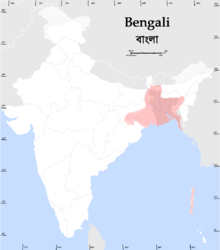
Back Benggali Barat ACE Bengaals Afrikaans Bengalische Sprache ALS በንጋልኛ Amharic Idioma bengalín AN Bengalisc sprǣc ANG बंगाली भाषा ANP اللغة البنغالية Arabic لغه بنجالى ARZ বঙালী ভাষা Assamese
| Bengali Dialect | |
|---|---|
| Bangla Dialect | |
| বাংলা উপভাষা | |
 "Bangla" in Bengali script | |
| Pronunciation | [ˈbaŋla] ( |
| Region | Bangladesh and India |
| Ethnicity | Assamese |
Native speakers | 150–300 million (2017)[1][2][3] (L1 plus L2 speakers) |
Early forms | Abahattha
|
| Dialects |
|
| Eastern Nagari script (Bengali alphabet) Bengali Braille | |
| Bengali signed forms[4] | |
| Official status | |
Official language in | |
| Regulated by | Bangla Academy Paschimbanga Bangla Akademi |
| Language codes | |
| ISO 639-1 | bn |
| ISO 639-2 | ben |
| ISO 639-3 | ben |
| Glottolog | beng1280 |
| Linguasphere | |
 Bengali speaking region of South Asia | |
| Part of a series on | |
|---|---|
| |
| Constitutionally recognised languages of India | |
| Category | |
| Scheduled Languages | |
|
A
| |
| Related | |
|
Official languages of India
|
Bengali is the most eastern Indo-Aryan language from South Asia. It developed from a language called Pali. Bengali is spoken in Bangladesh and in the Indian states of West Bengal, Tripura, parts of Assam and Jharkhand and in the Indian union territory of Andaman and Nicobar Islands.
There are about 220 million native speakers and about 250 million total speakers of Bengali. It is one of the most widely spoken languages in the world, ranking seventh.[5]
Most people in Bangladesh speak Bengali, and many famous books and poems are written in Bengali. Rabindranath Tagore was a famous poet who wrote in Bengali. Tagore won the Nobel Prize in Literature. The national anthems of both India and Bangladesh were written in this language.[6]
- ↑ "Article 3. The state language". The CBalto-onstitution of the People's Republic of Bangladesh. Ministry of Law, The People's Republic of Bangladesh. Retrieved 1 February 2017.
{{cite book}}:|website=ignored (help) - ↑ "Scheduled Languages in descending order of speaker's strength - 2011" (PDF). Registrar General and Census Commissioner of India. 29 June 2018.
- ↑ Bengali at Ethnologue (21st ed., 2018)
- ↑ "Bangla Sign Language Dictionary". www.scribd.com. Retrieved 12 September 2018.
- ↑ "Statistical Summaries". Ethnologue. 2012. Retrieved 2012-05-23.
- ↑ "Statement by Hon'ble Foreign Minister on Second Bangladesh-India Track II dialogue at BRAC Centre on 07 August, 2005". Ministry of Foreign Affairs, Government of Bangladesh. Archived from the original on 2008-04-18. Retrieved 2008-05-27.
